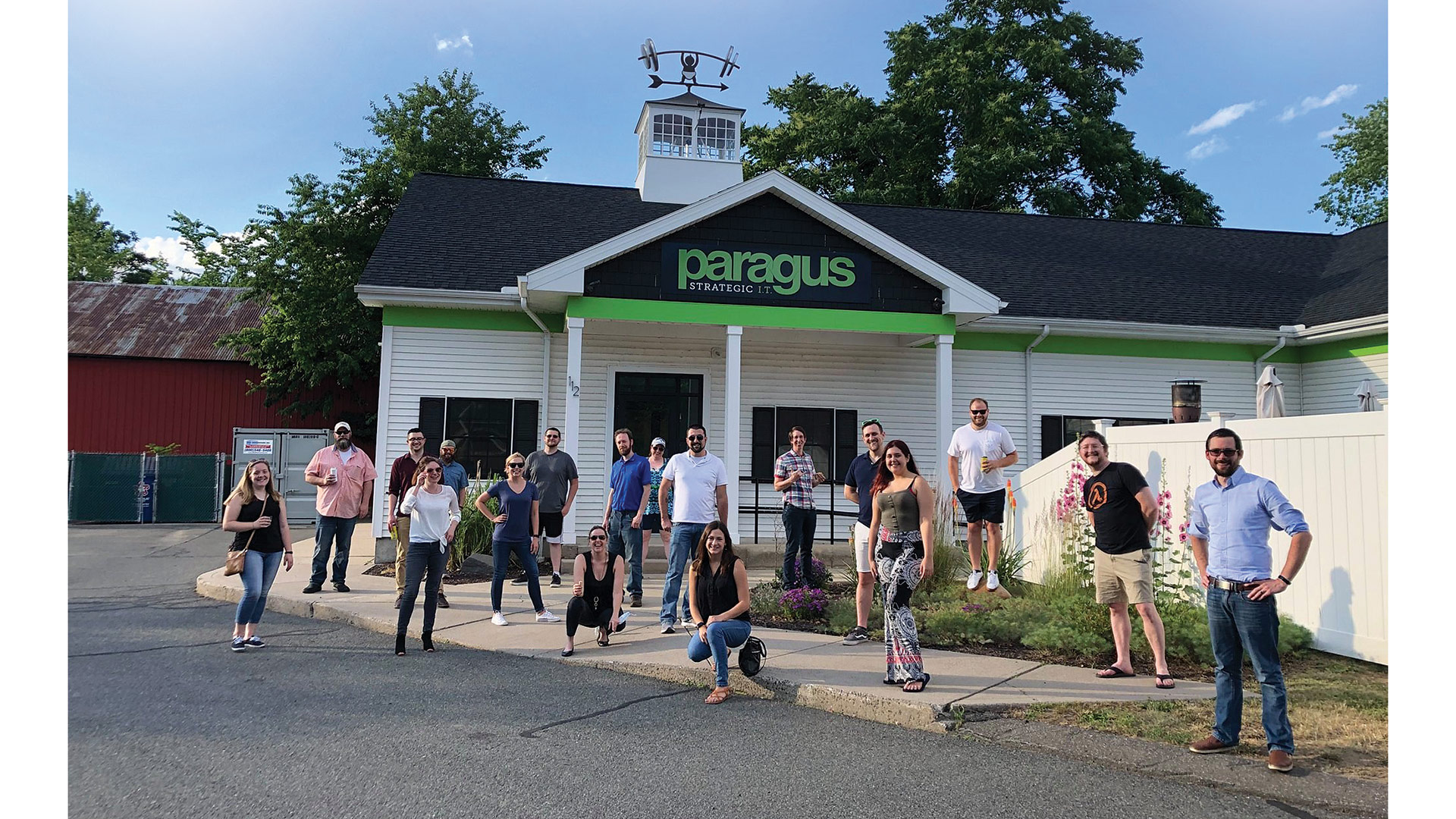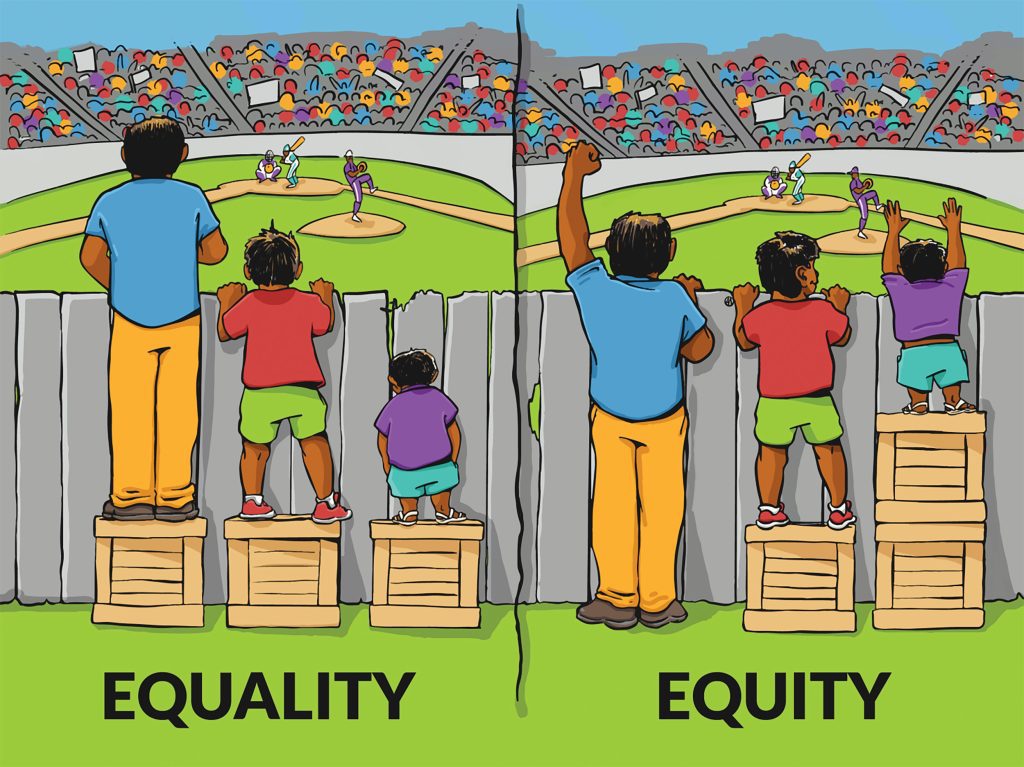Blurred Lines
During the pandemic, work arrangements were, in some ways, clearer than they are now — in short, remote work was the norm. Now, however, businesses and their employees are grappling with balancing company needs and culture with workers’ desire to maintain flexibility regarding when and where they get their jobs done. At the center of all of this is the amorphous, yet critically important, concept of work-life balance — and how, in some ways, remote work has made it even more challenging to achieve.

The employees at Paragus IT have been returning to the office — but will be allowed to keep working at home some days.
Getting work done during the pandemic was … messy, Delcie Bean said. But it got done.
“In the heat of the pandemic, we had to have maximum flexibility and understood that everyone was doing their absolute best to get done what needed to get done and make sure the clients were taken care of,” the CEO of Paragus IT told BusinessWest. “It was going to be messy, but we had to get through it.”
Emerging from COVID-19, then, has been a time for employers to assess what happened and what they learned about the many different ways people can get their work done — and still have time for themselves.
“What did we lose having everyone remote, and what did we gain?” Bean said. “We realized it was some of both columns A and B — there were certainly some benefits and some risks.
“Really, we found it’s very employee-specific,” he went on. “Some employees really need the structure of the office — they get up, commute, work in the office, commute, relax at home. That’s what helps them separate work from life. Others were really flourishing with a blend, doing work from home; they were good at setting up boundaries and not having their work bleed into their life.”
Despite the evidence showing that many workers flourish at home — achieving work-life balance by establishing firm boundaries — that blurring of lines between work time and family time is a concern, according to area company leaders we spoke with. The result, oddly enough, can be even less balance than before.
“With more people working from home and having increased autonomy over their work schedule, it becomes more challenging to differentiate between work time and personal time,” said Patricia Coughlin, Human Resources director at Wellfleet in Springfield.
In Bean’s case, the post-pandemic strategy that developed was to require employees to work in the Hadley office at least three days — a gradual shift, actually, beginning with one day in June, two days in July, and three days starting in August. Anyone who wants to be on site every day is welcome to do so.

Patricia Coughlin
“With more people working from home and having increased autonomy over their work schedule, it becomes more challenging to differentiate between work time and personal time.”
“There are certain things that are lost when you’re 100% remote,” he said, giving examples like mentoring new employees and collaborative projects. “But if remote is working for you, we don’t want to stop you.”
He understands that some people need to be in the office to function because they have too many distractions at home.
“It depends on their personality. My home is not a distraction at all — once the kids are in school, my home is quiet, with nothing to distract me,” he said, adding, however, that there’s also nothing there to energize him.
“I need energy from other people to function at my best. We all work a little differently, process things a little differently. A lot of flexibility is good, as long as that flexibility works for both the employees and the company — but working at home can lead to issues with work-life balance if the work never goes away.”
Amy Roberts, chief Human Resources officer at PeoplesBank in Holyoke, said the bank’s leaders learned the organization can be effective while incorporating different types of work arrangements.
“When the pandemic hit and we had to move to a remote workforce for much of our corporate team, there was no question that our associates were dedicated and would get the job done,” she noted. “We had concerns about remote work as it relates to data security, customer impact, and overall engagement of our workforce. But we saw pretty quickly that we were able to operate, meet the needs of our customers, and keep our team engaged.”
For that reason, the bank is now working to establish a hybrid model for many roles and will continue to evaluate increased flexibility for team members. “We may also consider fully remote roles, but at this time those will be very limited.”

Amy Roberts says PeoplesBank wants to develop strategies with its employees to avoid overly blurring the lines between work and family time, especially when working at home.
Like Bean, she noted that collaboration can suffer when people are not physically working together. “It’s such a big part of our day to day that we have to ensure people can easily get things done and make decisions as a team from anywhere. We feel this is an important aspect of any sustainable hybrid work model.”
Coughlin agreed that the pandemic made Wellfleet’s leaders more aware of the different ways people not only work well, but collaborate with their peers and find satisfaction in their work. As a result, the company plans to offer hybrid work arrangements and telework options as part of its model going forward.
“We learned from our employees that there is no one-size-fits-all methodology in creating an effective work environment,” she noted. “Throughout the pandemic, it became apparent that the ‘typical’ work arrangement may not be effective for all people.”
She added that this flexible approach is an attractive model that will allow Wellfleet to expand its talent pool while improving overall job satisfaction and increasing opportunities for growth and effectiveness. Again, however, the key is communication and setting boundaries.
“Supervisors and employees should set clear expectations of work schedules, availability, and when responses to e-mails are expected,” she said. “Maintaining this communication reduces the likelihood that employees feel the need to be available while on their personal time.”
Unhealthy Relationship
That latter concern is one employment experts across the country have been pondering. Constance Grady, a staff writer for Vox, recently penned an article titled “How Capitalism and the Pandemic Destroyed our Work-life Balance,” arguing that, in a precarious, COVID-disrupted economy, workers became even more attached to their work, in often-unhealthy ways.
“Those of us who were lucky enough to have jobs we could do from home brought our work into our living rooms, our kitchens, our bedrooms,” she wrote. “We pivoted. We shared strategies for how to be productive and overcome the stress of trying to work during a global health emergency. We challenged ourselves to meet and even exceed our pre-pandemic goals, against unfavorable odds. Despite everything, we prioritized work.”
But treating work as a sacred object has consequences, Grady argues. “We have treated work as something to be taken home and cherished. Work is our lover. And this year, we took it to bed.”
Bean understands that risk. “We’ve always strongly encouraged employees to have work-life balance as much as possible and encouraged people to unplug at the end of the day and not resume work until they’re back in the office again,” he said. “That worked much better in the pre-pandemic world, where there were cleaner lines between work and home.”
Paragus has long offered employees ‘discretionary time’ for personal obligations and appointments, which they can make up later. “We try to give employees freedom to schedule their work around what works for both them and the company.”
But over the past year, those lines blurred, with more people shifting their schedules or even working sporadically, a couple hours on and a couple off — especially when they were helping their homebound kids navigate the world of remote learning.
Hopefully, a return to something approaching normal, even if it does include some remote work, will sharpen those lines a bit. What helps, Bean said, is making firm decisions on what the home is actually for, especially at night.
“I’m very strict. When I get home, the phone goes on the counter and stays there until I go to bed. It’s rare for me to check e-mail at home, and it’s rare for me to work weekends. I try my best to model that you don’t need to work all night and on weekends to keep up; you can do your job during your work hours, then be with your family. You need that balance, and your family needs you there.”
Beyond that, he added, employees need to decompress from work in order to be productive the next day. “You need that separation time to process. You’re never able to let it sink in and reflect when you’re just going, going, going.”
Roberts agreed. “We are concerned about the blurring of lines with people who are working at home,” she said. “We are looking at this issue to determine if there are other ways we can ensure this balance with our plan for long-term workplace flexibility.”
Ideas include encouraging employees to work in a dedicated space, and at the end of the work day, leaving that room behind and closing the door — in other words, stick to the set work schedule.
“Obviously, if a customer issue occurs at the end of our day, we aren’t walking away, but in most cases we have seen that people have done a good job maintaining their normal work hours from any location — home or office.”
Understanding employee needs helps them to create balance while meeting the company’s needs, Coughlin added.
“When people have the flexibility to manage their schedule — for example, to attend a personal appointment and make up time later in the day — that can have a really positive impact on productivity. And everyone’s different; some people are more productive early in the morning, some are more productive in the evening, and others work best within a very set schedule.”
From a company perspective, she went on, it’s important to establish general standards that allow all employees the opportunity to achieve a healthy work-life balance — and it’s important to engage with employees to better identify what is meaningful to them.
“Work-life balance, and what that means, can really vary from person to person,” she noted. “One employee might be driven by the satisfaction in completing a task, while another takes satisfaction from counting hours ‘clocked in.’”
Creating a Culture
The bottom line, Coughlin said, is that Wellfleet’s people are fundamental in creating its culture, so it’s important to engage with them, through various platforms, to identify and implement ways to support a healthy work-life balance.
To that end, it offers education and trainings to improve work efficiencies, as well as communication regarding company benefits workers can utilize for personal purposes. Supervisors also work closely with employees to coach skills like prioritizing tasks, setting realistic goals, and time management.
“Wellfleet believes a healthy work-life balance fosters a culture in which employees are able to perform their job duties in a productive manner,” she added. “Good balance and increased flexibility in the workplace can help prevent burnout, reduce stress, and promote overall wellness.”
The company also offers employees the flexibility to adjust their work schedules to attend appointments and encourages them to use paid time off for their personal well-being, Coughlin said. “We saw the need to internally emphasize this message throughout the pandemic, although the ways we promoted this adapted to the circumstances.”
Wellfleet isn’t the only company re-emphasizing the need for workers to take time off, even if they’re not taking as many week-long vacations as before. HR Daily Advisor recently published a story on work-life balance that included input from several employers across the U.S. noting that employees have been de-emphasizing long vacations in favor of three-day weekends, staycations, and mental-health days off — as well as taking less time off overall.
“We have always focused on promoting a healthy work-life balance, and I don’t think remote work will change the way that we encourage our team to pay attention to this balance,” Roberts said. “Some of the ways that we promote this balance is our official work week being 38 hours, generous time-off plans, and fun team events and activities throughout the year. Our managers also do a good job of making sure they balance their expectations to ensure that a healthy work-life balance is a real thing.”
At the same time, Bean said, workers at any number of companies may have begun seeing those remote and flexible work models of the past 16 months as a permanent aspect of work-life balance — or, at least, they hope so. That could cause tension down the line, as employers, already struggling to retain talent in many industries, may have to negotiate such arrangements moving forward.
“However, another part of me knows behaviors and habits don’t change easily,” he added. “We, as a country, have 200 years of working 8 to 5 and going home. I don’t know if the pandemic was long enough to permanently break this muscle memory.”
If he’s right, companies adopting hybrid models now may eventually shift back to the typical, on-site work schedule of the past.
“Maybe people will work from home more than before,” he said. “But I don’t think this was that disruptive that we’ll fundamentally change the way we do work. It comes down to a lot of factors.”
Those factors range from employee desires to company needs and what type of culture an employer wants to promote. And the day might come when the current job surplus lessens and employers feel they have more leverage.
“How comfortable are you with making a decision, if an employer tells you to come back to the office or find new employment?” Bean said. “We’ll see how those things play out, and we’ll find out if the changes are temporary or long-term — and, if they’re long-term, how impactful they’ll be.”
Until then, employees will continue to get their work done in whatever way their company allows — and, hopefully, not take it to bed.
Joseph Bednar can be reached at [email protected]















 The holiday season that stretches from Thanksgiving into January is, in many ways, a cheerful time, one of togetherness, connection, and giving. But, in truth, many people dread the season for the stresses it brings — to finances, relationships, workload, you name it. While those stresses can’t be eliminated, they can often be managed through a combination of mindfulness, realistic expectations, and simply seeking help.
The holiday season that stretches from Thanksgiving into January is, in many ways, a cheerful time, one of togetherness, connection, and giving. But, in truth, many people dread the season for the stresses it brings — to finances, relationships, workload, you name it. While those stresses can’t be eliminated, they can often be managed through a combination of mindfulness, realistic expectations, and simply seeking help.


 While salary is still the most important aspect of a job for most, a new survey from the
While salary is still the most important aspect of a job for most, a new survey from the 
